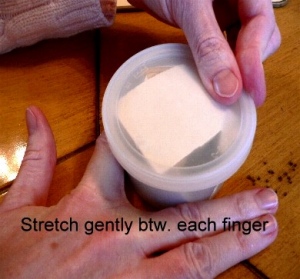Written by Cynthy Johnson,
Co-authored by Kim Kovac, MS, PT, CHT
Stretch before you warm up, and warm up, before you run! If this sounds a little bit like a recommendation prior to an athletic event, in some ways it is, although the event is the running of your fingers up and down the harp strings of your favorite harp! My hope is that these hand exercises may make as much difference to you as they have to me.
Years ago, when I started to play the pedal and lever harp, I began experiencing tremendous pain in my fingers and joints. My knuckles were red and swollen and I had developed a ganglion cyst just beneath my index finger of my right hand. In addition, I could not open my hands upon arising in the morning.
Concerned, I consulted a rheumatologist. The doctor examined my hand joints and indicated I probably had early-onset osteoarthritis. My doctor injected the swollen joints with cortisone (ouch!) and prescribed a medication for arthritic pain. At a follow-up appointment there was no improvement. My doctor stated that I needed to slow down or consider not playing harp.
I was devastated! How could I stop playing the beautiful harps that graced my living room-turned-harp room? How could I stop my work as a Certified Therapeutic Harp Practitioner?
“No! There has to be another way.” were my words to my doctor. My doctor offered me a referral to a Hand Therapist. The very next week I met Kim Kovac, MS, PT, CHT, one of the leading hand therapists on the U.S. East Coast.
Kim examined my hands; but most of all, she listened to me. I brought my harp along to the appointment, and Kim watched how my hands and fingers operated; most especially where I put stress and tension on my joints. “Cynthy presented joint restriction and tightness in the small muscles of both hands, as well as inflammation in the both thumb joints and the left index finger joint”, stated Kim Kovac. “Part of her treatment was to create custom splints used to decrease the stress to the joints while allowing her to play the harp. In addition, providing custom splints to rest the joints to decrease the inflammation. I also presented Cynthy with exercises to increase flexibility of the small muscles in her hands and ideas for modifying home activities to decrease stress.”
I felt that after the inflammation had subsided, the most important part of my treatment was the regular stretching exercises for my hands that Kim taught me. These simple hand exercises, when practiced daily, and before I played harp, stretched and strengthened the small muscles in my hands, and increased over all flexibility. Where I once could barely stretch an octave, I can now stretch to a tenth or thirteenth. Where I once had difficulty grasping four notes in a chord, I can grasp them quickly and in succession. Where I once could not obtain speed in playing, I have greater flexibility and agility. Moreover, there is no pain in any of my joints, I no longer have a ganglion cyst, I longer need splints, and I no longer need cortisone injections!
Now, years later, as a harpist and harp teacher, after consulting Kim Kovac, I have since shared these hand exercises with my harp students, and they have achieved wonderful results. I have also shared these exercises with many other harpists and harpers.
My hope is that these stretches will become part of your warm up routine, so that once you stretch before you warm-up, you can run your fingers on your favorite harp!
The following exercises are not a substitute for medical treatment. It is advised that you consult your health care professional before commencing upon any form of exercise.
Hand Exercise #1: Palm Stretch
Stretches the small muscles in the hand; permitting more flexibility in the hand.
Hand Exercise #2: Web Stretch
Stretches the small muscles in the hand and between the ligaments in the hands.
Hand Exercise #3: Finger Stretch
Stretches the fingers and allows for more flexibility in the joints.
Exercise #4: Forearm Stretch
Stretches the small and long muscles in the forearm for flexibility, and releasing tension.
The late Cynthy Johnson was a Harpist, Harp Instructor, Workshop Presenter, and Certified Therapeutic Harp Practitioner.






